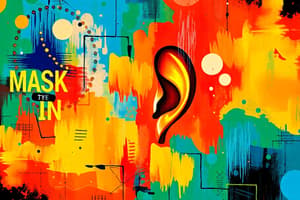Podcast
Questions and Answers
What does masking refer to in the context of hearing tests?
What does masking refer to in the context of hearing tests?
- Using different wavelengths to assess sound perception
- Testing the sensitivity of the auditory nerve
- Enhancing the loudness of a signal in the ear
- Making a tone inaudible due to surrounding noise (correct)
In clinical masking, where is the noise delivered?
In clinical masking, where is the noise delivered?
- To both ears simultaneously
- To the external environment
- Only to the test ear
- To the non-test ear (correct)
Which of the following statements is true regarding the application of clinical masking?
Which of the following statements is true regarding the application of clinical masking?
- Noise must be presented in the test ear for accurate measurement.
- Masking noise is delivered to the non-test ear for effective hearing assessment. (correct)
- The test signal can only be assessed through bone-conduction.
- The same type of noise is used regardless of the type of test signal.
What is the primary purpose of using clinical masking in hearing tests?
What is the primary purpose of using clinical masking in hearing tests?
In what manner is noise typically delivered to the non-test ear during clinical masking?
In what manner is noise typically delivered to the non-test ear during clinical masking?
Flashcards
Masking
Masking
Making a tone inaudible by introducing noise in the same ear.
Clinical Masking
Clinical Masking
Clinical masking is a technique used to prevent sound from traveling to the non-tested ear, ensuring only the tested ear is being evaluated.
Nontest Ear (NTE)
Nontest Ear (NTE)
The ear that's not being tested.
Test Ear (TE)
Test Ear (TE)
Signup and view all the flashcards
Masking Noise Delivery
Masking Noise Delivery
Signup and view all the flashcards
Study Notes
Masking Definition
- Masking renders a sound inaudible due to a simultaneous noise in the same ear.
- Masking the right ear involves a noise presented to that ear, preventing a tone from being heard.
Clinical Masking
- Clinical masking reduces cross-hearing during hearing tests.
- Masking noise is presented to the non-test ear (NTE).
- The test signal is presented to the test ear (TE).
- The noise is delivered to the NTE via air conduction, regardless of the testing method (air or bone conduction) for the TE.
Masking Noise Considerations
- The selection of appropriate masking noise depends on the signal being tested.
- This detail is discussed in a later section.
- The notes presume appropriate masking noise is used.
Studying That Suits You
Use AI to generate personalized quizzes and flashcards to suit your learning preferences.
Description
Explore the concept of masking in hearing science, including its definition, clinical applications, and considerations for selecting appropriate masking noise. This quiz will test your understanding of how masking affects hearing tests and signal perception.




